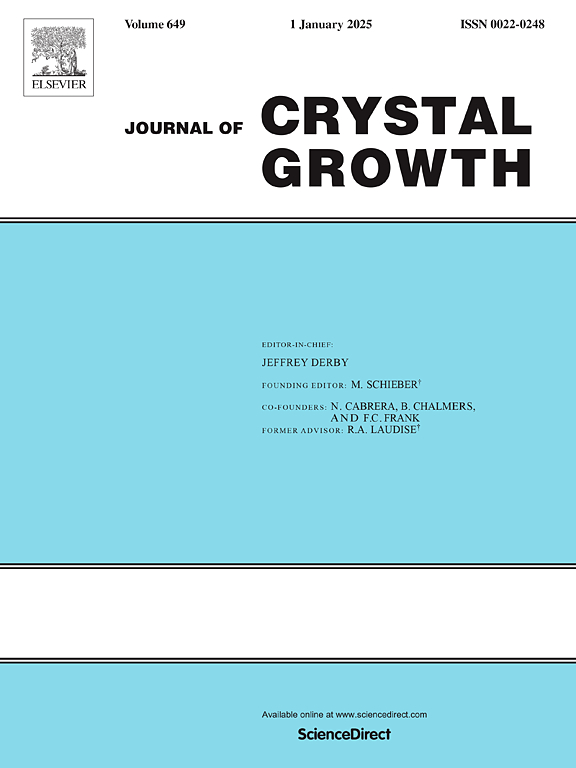As2通量对分子束外延生长InAs/InGaAs点孔结构的影响
IF 1.7
4区 材料科学
Q3 CRYSTALLOGRAPHY
引用次数: 0
摘要
本研究系统地研究了InAs/InGaAs点孔(DWELL)结构在InAs点层生长过程中广泛使用As2通量的生长情况。发现As2通量对DWELL结构的生长起着非常重要的作用,它从根本上影响着in原子的迁移长度和解吸速率。在不同的As2通量下,观察到InAs量子点(QDs)密度的非单调变化。此外,量子点的平均宽度和高度也与As2通量有关。DWELL结构的光致发光(PL)峰值强度与As2通量有显著的关系,其中使用优化后的As2通量可使发光强度最大增强90%。在研究的As2通量范围内,在峰值发射波长处观测到58 nm的总红移。此外,这是第一个实验证据,证明了当量子点在低As2通量下生长时,DWELL结构中的量子点可能不会被InGaAs层完全覆盖。因此,QD的未封顶部分可能发生分解,导致DWELL结构的PL发射峰发生较大的蓝移。本文章由计算机程序翻译,如有差异,请以英文原文为准。
Effect of As2 flux on the growth of InAs/InGaAs dot-in-well structure by molecular beam epitaxy
This study systematically investigates the growth of InAs/InGaAs dot-in-well (DWELL) structure with a wide range of As2 flux employed during the growth of InAs dot layer. It is found that As2 flux plays a very important role in the growth of the DWELL structure, which fundamentally affects the migration length and the desorption rate of In atoms. A non-monotonic variation in the density of InAs quantum dots (QDs) has been observed with varying As2 flux. In addition, the average width and height of QDs also depends on the As2 flux. The photoluminescence (PL) peak intensity from the DWELL structure exhibits a remarkable relationship with the As2 flux, where a maximum intensity enhancement of 90 % was achieved by using the optimized As2 flux. A total redshift of 58 nm in the peak emission wavelength has been observed within the As2 flux range studied. Moreover, it has been the first experimental evidence for a distinctive phenomenon that the QDs in the DWELL structure might not be fully capped by the InGaAs layer when the QDs were grown with low As2 fluxes. Therefore, decomposition of the uncapped portion of QD may occur, resulting in a large blueshift of the PL emission peak from the DWELL structure.
求助全文
通过发布文献求助,成功后即可免费获取论文全文。
去求助
来源期刊

Journal of Crystal Growth
化学-晶体学
CiteScore
3.60
自引率
11.10%
发文量
373
审稿时长
65 days
期刊介绍:
The journal offers a common reference and publication source for workers engaged in research on the experimental and theoretical aspects of crystal growth and its applications, e.g. in devices. Experimental and theoretical contributions are published in the following fields: theory of nucleation and growth, molecular kinetics and transport phenomena, crystallization in viscous media such as polymers and glasses; crystal growth of metals, minerals, semiconductors, superconductors, magnetics, inorganic, organic and biological substances in bulk or as thin films; molecular beam epitaxy, chemical vapor deposition, growth of III-V and II-VI and other semiconductors; characterization of single crystals by physical and chemical methods; apparatus, instrumentation and techniques for crystal growth, and purification methods; multilayer heterostructures and their characterisation with an emphasis on crystal growth and epitaxial aspects of electronic materials. A special feature of the journal is the periodic inclusion of proceedings of symposia and conferences on relevant aspects of crystal growth.
 求助内容:
求助内容: 应助结果提醒方式:
应助结果提醒方式:


